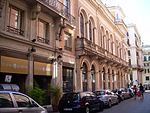Palazzo Poli
Baroque architecture in RomeItalian palace stubsLuigi Vanvitelli buildingsPalaces in RomeRome R. II Trevi

The Palazzo Poli is a palace in Rome, Italy, that was altered to form the backdrop to the Trevi Fountain. The central portion of the palace was demolished to provide room for the large fountain in 1730. As a setting for the fountain, Luigi Vanvitelli gave the building a new monumental facade that contains the giant order of Corinthian pilasters linking the two main storeys of the palace.In the 1830s, Princess Zinaida Volkonskaya threw lavish parties in this palace. The Palazzo Poli houses a collection of copper engraving plates dated from the sixteenth century to the present. The Palazzo also houses the Istituto Nazionale per la Grafica.
Excerpt from the Wikipedia article Palazzo Poli (License: CC BY-SA 3.0, Authors, Images).Palazzo Poli
Via della Stamperia, Rome Municipio Roma I
Geographical coordinates (GPS) Address External links Nearby Places Show on map
Geographical coordinates (GPS)
| Latitude | Longitude |
|---|---|
| N 41.901111111111 ° | E 12.483055555556 ° |
Address
Palazzo Poli
Via della Stamperia
00187 Rome, Municipio Roma I
Lazio, Italy
Open on Google Maps










